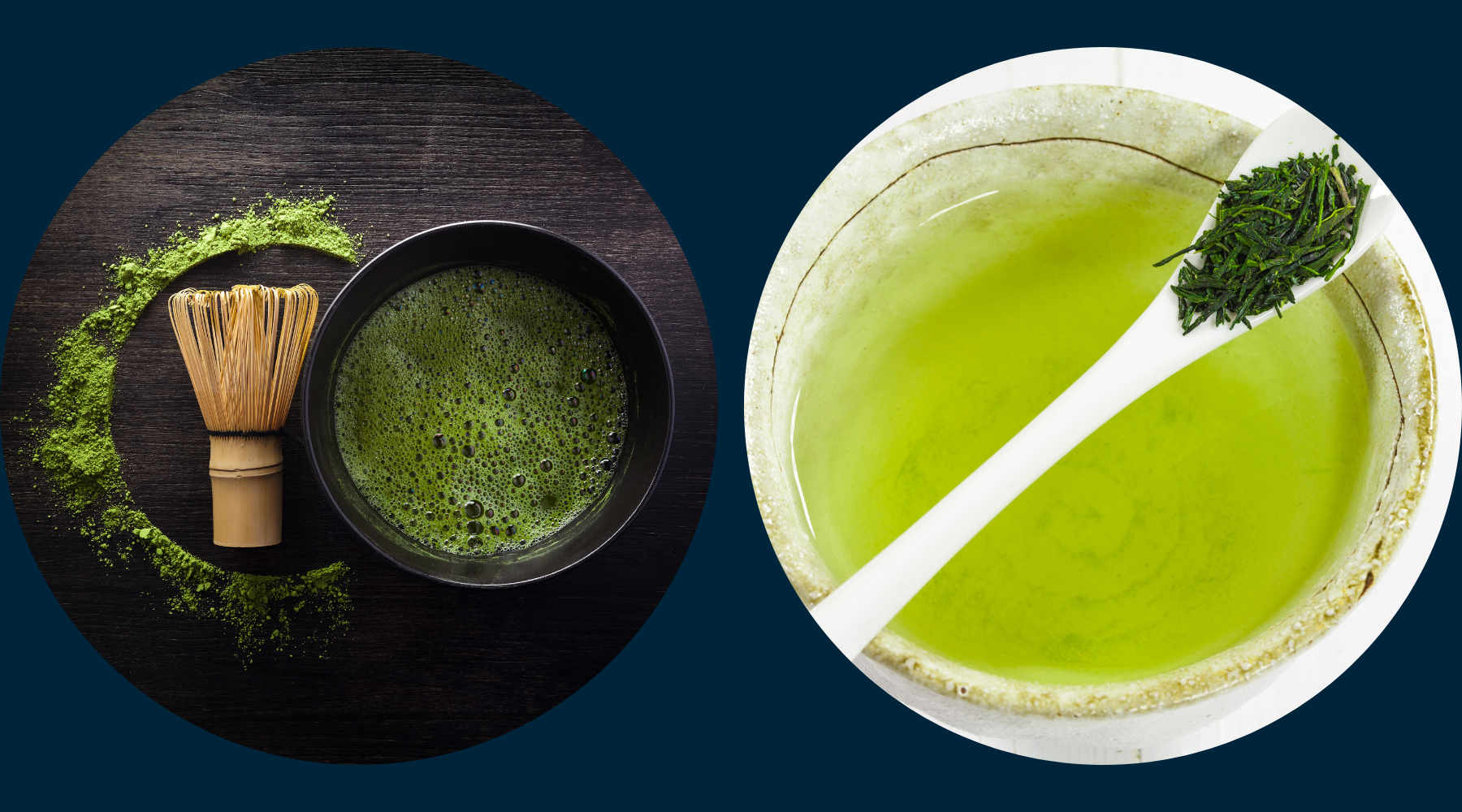
Matcha vs. Gyokuro: Die Unterschiede
Versand am April 26 2023,

Matcha vs. Gyokuro: Die Unterschiede
Einführung
Matcha und Gyokuro sind beides bekannte japanische Grüntees, die aus der Pflanze Camellia sinensis gewonnen werden. Aber kennen Sie die wichtigsten Unterschiede zwischen ihnen? In diesem Artikel tauchen wir in die faszinierende Welt dieser beiden Teesorten ein und vergleichen ihre Herkunft, Herstellung, Geschmacksprofile, gesundheitlichen Vorteile, Brühtechniken, kulinarischen Verwendungsmöglichkeiten und vieles mehr.
Lassen Sie uns also eintauchen und herausfinden, welcher Tee zu Ihrem Geschmack und Lebensstil passt!
Die Ursprünge
Matcha
Matcha, mit seiner leuchtend grünen Farbe, stammt aus dem 12. Jahrhundert, als Zen-Buddhisten ihn aus China nach Japan brachten. Zunächst von Kaisern und der Elite verwendet, entwickelte sich Matcha-Tee bald zu einem beliebten Alltagsgetränk. Heute ist er weltweit für seinen unverwechselbaren Geschmack und seine gesundheitsfördernden Eigenschaften bekannt.
Gyokuro
Gyokuro, auch bekannt als „Jadetau“, ist ein hochwertiger Grüntee, der im 19. Jahrhundert in Japan entstand. Wie Matcha wächst Gyokuro im Schatten, seine Blätter werden jedoch sorgfältig von Hand gepflückt und anschließend zu feinen, nadelartigen Formen gerollt. Dieses einzigartige Verfahren verleiht Gyokuro seinen unverwechselbaren Geschmack und sein Aussehen.
Abonnieren Sie den RSS-Feed dieses Blogs unter http://premium-health-japan.myshopify.com/blogs/news.atom
Produktionsprozess
Schattenanbautechnik
Sowohl Matcha als auch Gyokuro werden im Schatten angebaut, d. h. sie werden vor der Ernte etwa 20 bis 30 Tage lang unter Dach kultiviert. Dieses Verfahren erhöht den Chlorophyllgehalt und reduziert die Tannine, was beiden Tees ihre charakteristische Süße und ihren Umami-Geschmack verleiht.
Ernte und Verarbeitung
Für Matcha werden die Blätter gedämpft, getrocknet und anschließend zu feinem Pulver gemahlen. Gyokuro hingegen wird geerntet, gedämpft und vor dem Trocknen zu dünnen, nadelartigen Teeblättern gerollt. Dieser Unterschied in der Verarbeitung beeinflusst den Geschmack und die Zubereitung der Tees.
Geschmacksprofile
Matcha
Matcha ist bekannt für seinen intensiven, umamireichen Geschmack mit einer leichten Süße und einer cremigen Textur. Er hat eine leuchtend grüne Farbe und ein starkes, grasiges Aroma.
Gyokuro
Gyokuro bietet einen zarten, süßen Geschmack mit einem reichen Umami-Aroma und einem seidigen Mundgefühl. Er hat eine tiefgrüne Farbe und ein frisches, grasiges Aroma mit einem Hauch von Seetang.
Gesundheitliche Vorteile
Matcha
Matcha ist reich an Antioxidantien, insbesondere Catechinen, die für ihre krebsbekämpfenden Eigenschaften bekannt sind. Außerdem enthält es L-Theanin, eine Aminosäure, die Entspannung fördert und Stress abbaut. Matcha sorgt für einen sanften Koffeinschub und ist damit eine hervorragende Alternative zu Kaffee für anhaltende Energie ohne Angstzustände.
Gyokuro
Gyokuro bietet viele der gleichen gesundheitlichen Vorteile wie Matcha, darunter einen hohen Gehalt an Antioxidantien und L-Theanin. Da Gyokuro-Blätter jedoch später geerntet werden, enthält er einen etwas höheren Koffeingehalt als Matcha und ist daher eine gute Wahl für alle, die einen stärkeren Energieschub suchen.
Brautechniken
Matcha
Zur Zubereitung von Matcha wird das Matcha-Pulver mit heißem Wasser mit einem Bambusbesen schaumig geschlagen. Die ideale Wassertemperatur für Matcha liegt bei 70–80 °C.
Gyokuro
Gyokuro wird aus ganzen Teeblättern gebrüht und benötigt eine niedrige Wassertemperatur von 60–70 °C, um seine feinen Aromen zu entfalten. Die Ziehzeit beträgt in der Regel 1–2 Minuten, und Sie können mehrere Aufgüsse derselben Teeblätter genießen.
Kulinarische Verwendung
Matcha
Matcha ist vielseitig einsetzbar und eignet sich perfekt für verschiedene Rezepte wie Smoothies, Lattes, Backwaren und sogar herzhafte Gerichte. Seine leuchtend grüne Farbe und sein einzigartiger Geschmack verleihen jedem Gericht eine raffinierte Note.
Gyokuro
Obwohl Gyokuro in der Küche nicht so häufig verwendet wird wie Matcha, kann er dennoch in Rezepte eingearbeitet werden, die grünen Tee erfordern. Sein subtiles Geschmacksprofil eignet sich gut für delikate Gerichte wie Desserts, Salate oder sogar als einfacher Eistee.
Matcha vs. Gyokuro – Koffein
Beim Vergleich von Matcha und Gyokuro ist es wichtig, den Koffeingehalt zu berücksichtigen, da dieser je nach Empfindlichkeit oder persönlichen Vorlieben Ihre Wahl beeinflussen kann.
Matcha
Matcha enthält je nach Sorte und Zubereitungsart etwa 30–70 Milligramm Koffein pro 230-ml-Portion. Diese Menge ist etwas höher als bei normalem Grüntee, aber niedriger als in einer Tasse Kaffee. Daher ist Matcha eine beliebte Wahl für einen ausgewogeneren und gleichmäßigeren Energieschub ohne Angstzustände.
Gyokuro
Gyokuro enthält etwa 40–80 Milligramm Koffein pro 230-ml-Portion und ist damit etwas koffeinreicher als Matcha. Dies liegt an der späteren Erntephase der Blätter, wodurch die Teepflanze mehr Koffein entwickeln kann. Der höhere Koffeingehalt von Gyokuro sorgt für einen stärkeren, nachhaltigeren Energieschub und ist daher die ideale Wahl für alle, die eine Alternative zu Kaffee mit zusätzlichen gesundheitlichen Vorteilen suchen.
Die richtige Wahl treffen
Berücksichtigen Sie bei der Wahl zwischen Matcha und Gyokuro aufgrund des Koffeingehalts Ihre persönlichen Vorlieben und Ihre Koffeinempfindlichkeit. Wenn Sie einen milderen, ausgewogeneren Energieschub suchen, ist Matcha möglicherweise die richtige Wahl. Bevorzugen Sie jedoch einen etwas stärkeren Koffeinkick, könnte Gyokuro die perfekte Option sein.
Bedenken Sie, dass beide Teesorten einzigartige Geschmackserlebnisse und gesundheitliche Vorteile bieten. Wenn Sie also mit beiden experimentieren, können Sie die perfekte Balance für Ihren Lebensstil finden.
Preisüberlegungen
Gyokuro ist aufgrund seines arbeitsintensiven Herstellungsprozesses und der begrenzten Verfügbarkeit im Allgemeinen teurer als Matcha. Beide Teesorten sind jedoch in verschiedenen Qualitäten und Preisklassen erhältlich, sodass Sie Optionen finden, die zu Ihrem Budget passen.
Die Wahl des richtigen Tees für Sie
Berücksichtigen Sie bei der Entscheidung zwischen Gyokuro und Matcha Ihre Geschmacksvorlieben, Ihre Gesundheitsziele und Ihre Zubereitungstechnik. Wenn Sie einen kräftigen, umamireichen Geschmack und die Bequemlichkeit von Pulvertee mögen, könnte Matcha die richtige Wahl sein. Bevorzugen Sie einen feineren, süßeren Geschmack und das Erlebnis, ganze Teeblätter aufzubrühen, könnte Gyokuro der ideale Tee für Sie sein.
Abschluss
Letztendlich bieten sowohl Matcha als auch Gyokuro einzigartige Geschmackserlebnisse und gesundheitliche Vorteile. Vielleicht genießen Sie beide Teesorten sogar zu unterschiedlichen Anlässen. Warum also nicht die Welt des japanischen Grüntees erkunden und die köstlichen Nuancen von Matcha und Gyokuro entdecken?
FAQs
-
Was ist der Hauptunterschied zwischen Matcha und Gyokuro? Der Hauptunterschied liegt in der Verarbeitung: Matcha wird zu feinem Pulver gemahlen, während Gyokuro zu nadelartigen Formen gerollt wird. Dies beeinflusst ihr Geschmacksprofil, ihre Zubereitungsmethoden und ihre kulinarische Verwendung.
-
Welcher Tee hat mehr Koffein, Matcha oder Gyokuro? Gyokuro hat aufgrund der späteren Ernte seiner Blätter normalerweise einen etwas höheren Koffeingehalt als Matcha.
-
Kann ich in Rezepten Gyokuro durch Matcha ersetzen und umgekehrt? Obwohl es möglich ist, die eine Sorte durch die andere zu ersetzen, sollten Sie sich bewusst sein, dass die unterschiedlichen Geschmacksprofile und Texturen das Endergebnis des Gerichts beeinflussen können. Am besten experimentieren Sie und passen die Menge oder Zubereitung nach Bedarf an, um den gewünschten Geschmack zu erzielen.
-
Wie lange bleiben Matcha und Gyokuro frisch? Um die Frische zu gewährleisten, sollten Matcha und Gyokuro in einem luftdichten Behälter, geschützt vor Licht, Feuchtigkeit und starken Gerüchen, aufbewahrt werden. Matcha sollte im Allgemeinen innerhalb von 3–6 Monaten nach dem Öffnen verzehrt werden, während Gyokuro bis zu einem Jahr frisch bleibt.
-
Sind Matcha und Gyokuro für Menschen mit Koffeinunverträglichkeit geeignet? Sowohl Matcha als auch Gyokuro enthalten Koffein, allerdings in unterschiedlichen Mengen. Wenn Sie empfindlich auf Koffein reagieren, sollten Sie diese Tees in Maßen genießen, auf koffeinärmere Alternativen zurückgreifen oder einen Arzt um Rat fragen.
Erfahren Sie mehr über Matcha:
